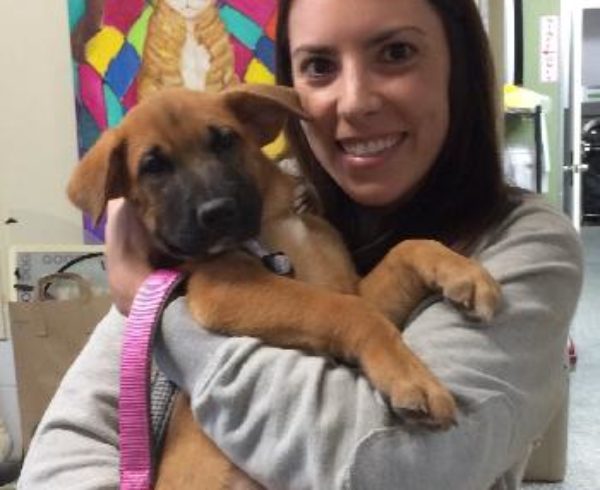PREPPING FOR YOUR DOG
As we wrap up National Adopt A Shelter Pet day we though it would be a good time to provide you with information about what you need to do to prepare for becoming a new adoptive pet parent.
The first few days in your home are special and critical for a pet. Your new dog will be confused about where he is and what to expect from you. Setting up some clear structure with your family for your dog will be paramount in making as smooth a transition as possible.
Before You Bring Your Dog Home:
-
Determine where your dog will be spending most of his time. Because he will be under a lot of stress with the change of environment (from shelter or foster home to your house), he may forget any housebreaking (if any) he’s learned. Often a kitchen will work best for easy clean-up.
-
If you plan on crate training your dog, be sure to have a crate set-up and ready to go for when you bring your new dog home. Find out more about crate training your dog.
-
Dog-proof the area where your pooch will spend most of his time during the first few months. This may mean taping loose electrical cords to baseboards; storing household chemicals on high shelves; removing plants, rugs, and breakables; setting up the crate, and installing baby gates.
-
Training your dog will start the first moment you have him. Take time to create a vocabulary list everyone will use when giving your dog directions. This will help prevent confusion and help your dog learn his commands more quickly. Not sure which commands to use? Check out How to Talk to Your Dog.
-
Bring an ID tag with your phone number on it with you when you pick up your dog so that he has an extra measure of safety for the ride home and the first few uneasy days. If he is microchipped, be sure to register your contact information with the chip’s company, if the rescue or shelter did not already do so.
First Day:
-
We know moving is stressful — and your new dog feels the same way! Give him time to acclimate to your home and family before introducing him to strangers. Make sure children know how to approach the dog without overwhelming him. Go here for more on introducing dogs and children.
-
When you pick up your dog, remember to ask what and when he was fed. Replicate that schedule for at least the first few days to avoid gastric distress. If you wish to switch to a different brand, do so over a period of about a week by adding one part new food to three parts of the old for several days; then switch to half new food, half old, and then one part old to three parts new. For more information about your dog’s diet, check out our section on Dog Nutrition.
-
On the way home, your dog should be safely secured, preferably in a crate. Some dogs find car trips stressful, so having him in a safe place will make the trip home easier on him and you.
-
Once home, take him to his toileting area immediately and spend a good amount of time with him so he will get used to the area and relieve himself. Even if your dog does relieve himself during this time, be prepared for accidents. Coming into a new home with new people, new smells and new sounds can throw even the most housebroken dog off-track, so be ready just in case. Need more housetraining tips? Check out our Dog Housetraining
-
If you plan on crate training your dog, leave the crate open so that he can go in whenever he feels like it in case he gets overwhelmed. Also, be sure to check out the do’s and don’ts of crate training your dog.
-
From there, start your schedule of feeding, toileting and play/exercise. From Day One, your dog will need family time and brief periods of solitary confinement. Don’t give in and comfort him if he whines when left alone. Instead, give him attention for good behavior, such as chewing on a toy or resting quietly (Source: Preparing Your Home For A New Dog).
-
For the first few days, remain calm and quiet around your dog, limiting too much excitement (such as the dog park or neighborhood children). Not only will this allow your dog to settle in easier, it will give you more one-on-one time to get to know him and his likes/dislikes.
-
If he came from another home, objects like leashes, hands, rolled up newspapers and magazines, feet, chairs and sticks are just some of the pieces of “training equipment” that may have been used on this dog. Words like “come here” and “lie down” may bring forth a reaction other than the one you expect. Or maybe he led a sheltered life and was never socialized to children or sidewalk activity. This dog may be the product of a never-ending series of scrambled communications and unreal expectations that will require patience on your part.
Following Weeks:
-
People often say they don’t see their dog’s true personality until several weeks after adoption. Your dog may be a bit uneasy at first as he gets to know you. Be patient and understanding while also keeping to the schedule you intend to maintain for feeding, walks, etc. This schedule will show your dog what is expected of him as well as what he can expect from you.
-
After discussing it with your veterinarian to ensure your dog has all the necessary vaccines, you may wish to take your dog to group training classes or the dog park. Pay close attention to your dog’s body language to be sure he is having a good time — and is not fearful or a dog park bully. If you’re unsure of what signs to watch for, check out this video on safety at the dog park.
-
To have a long and happy life together with your dog, stick to the original schedule you created, ensuring your dog always has the food, potty time and attention he needs. You’ll be bonded in no time! For more information on creating a feeding schedule for your dog visit How Often Should You Feed Your Dog?
-
If you encounter behavior issues you are unfamiliar with, ask your veterinarian for a trainer recommendation. Select a trainer who uses positive-reinforcement techniques to help you and your dog overcome these behavior obstacles. Visit Dog Training for more information on reward-based training.
PREPPING FOR YOUR CAT
Be prepared should be your mantra when bringing a new pet into your home. Cats are particularly sensitive to new surroundings and some may hide under a bed or in a closet for days or even weeks. You can avoid pitfalls with your new critter and help him or her adapt more easily by following these guidelines:
Before You Bring Your Cat Home:
-
Cats are territorial, and coming into a new home leaves them feeling really uneasy. There’s all that unexplored space, and who knows what may lurk there. Do him a favor and provide a small area to call his own for the first few days or weeks. A bathroom or laundry room works well. Furnish the room with cat amenities, such as food, water and a litter box. You’ll want to spend time with your cat, so make sure there’s a comfortable place for you to sit as well.
-
Fill a litter box with one or two inches of litter and place it in his room where he can use it undisturbed. After all, everyone deserves a modicum of privacy when pottying, and giving him that will help forestall litter box aversion. Not sure which litter to choose? Check out How to Choose A Cat Litter.
-
Set up a feeding station with food and water bowls. Locate it away from the litter box. For more cat feeding and nutrition tips, visit our Pet Nutrition
-
Cats love to get away from it all in small places, and you can provide one for your new cat as his own little safe haven. If he came home in a cat carrier, that might be a good choice. You can also make one by cutting a doorway for her in the end of a box. If you prefer, you can buy a covered cat bed at a pet supply store. In either case, make sure the space is big enough for the cat to stand up and turn around in. Cat “feng shui” probably requires that he or she be able to see the door to the room from his hidey hole, so he won’t be startled.
-
A cat’s claws need to be worn down, and they do this by scratching on things. Since you prefer that it not be your chairs and sofa, provide your cat with a socially acceptable scratching place. Some types are made of corrugated cardboard and lie on the floor; others are posts which have to be tall enough so that the cat can extend himself upward to scratch. You can encourage your cat (once he has arrived) to use the post by sprinkling it with catnip or dangling a toy at the top. He’ll get the idea. You’ll probably want a scratching post in each room where there is soft furniture, perhaps blocking access to it. You can also install sticky tape (available at pet supply stores) to corners of upholstered furniture to dissuade scratching. Don’t miss these tips on how to cut down on kitty’s scratching, how to choose a scratching post, and facts about declawing cats.
-
Look at your house with a curious cat’s eye view for its climbing and exploring potential. When your cat is acclimated to your home, you may be surprised to find him on top of the upper kitchen cabinets, so make sure there’s nothing on display there or on other high shelves that can be damaged or knocked off.
-
Look for holes or registers that leave ductwork accessible and cover them up. A kitten can easily slither into one of these. You won’t want firemen in the house, jackhammering the concrete floor to extract your cat.
-
If possible, buy a cat tree for your new family member. Cats like to survey their territory, so a high perch is often a favored resting place.
-
If there are other human family members, go over the ground rules about your new pet. Remind them not to startle him and to keep the door to his room shut.
-
Bone up on how to introduce your cat to other pets. Keep her door closed and don’t let your other pet race in unexpectedly. See also: New Cat Introductions and Living with Cats and Dogs.
First Day:
Now, you are ready for your cat’s homecoming. Preferably, bring her home in a cat carrier. It will feel safer to her. She has seen a lot of excitement, so take her directly to her new room. (Make sure the toilet lid is down, if she’s to acclimate in your bathroom.) Ideally, you would restrict her exposure to the whole family, but naturally, everyone is going to want to see her. Remind them of the ground rules you’ve set up.
-
Sit on the floor and let her come to you. Don’t force her. Just let her get acquainted on her own time. If she doesn’t approach, leave her alone and try again later. Some cats are particularly frightened, and she may retreat to her hidey hole and not come out when you’re around at all. She may only come out at night when the house is quiet. Give her time.
-
Your newly adopted cat may not eat much or at all at first. It’s best to give your cat the same food she had at the shelter or in her foster home, at least at first. Keeping some things familiar will make her feel more secure. Be sure to change her water frequently and make sure that she is drinking. If your cat hasn’t eaten for a few days, call your vet to ask for advice.
Following Weeks:
It may take your cat a week or two to adjust. Be patient.
-
Within a week of being adopted, take your newly adopted cat for her first wellness visit with a veterinarian. If you have a record of immunizations from the shelter, take it with you. Don’t have a vet? Check out these tips for finding the right vetfor you and your cat.
-
As your cat adjusts, she’ll show signs that she wants to explore outside her safe haven. Make sure other pets or family members won’t startle her while she gradually expands her territory. She may be ready to play, so you can furnish some toys. Many cats like feather wands from the pet supply store, but homemade toys are often favored. A wad of a tissue paper to bat around or a paper bag to hide in can be fun. For more ideas on how to keep your cat entertained see Keeping Your Cat from Getting Bored.
THANKS TO OUR FRIENDS AT PET FINDER FOR ALL OF THE RECOMMENDATIONS
-
If you didn’t get the chance to see the adoptable dogs and cats we introduced last week
then take a moment to look here! -
 And… don’t forget to visit
And… don’t forget to visit
https://abandonedpetrescue.org/adopt/
to meet all of the dogs and cats waiting for a forever home.


















